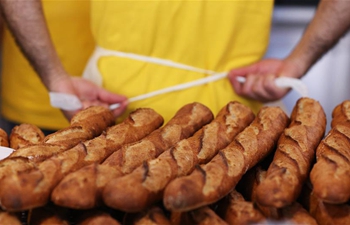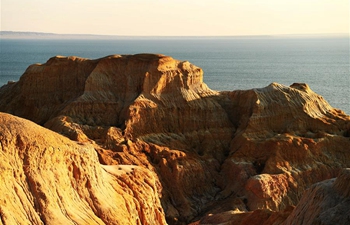WASHINGTON, May 12 (Xinhua) -- A legendary car driven by James Bond in 1964 007 movie "Goldfinger," a full-face latex mask which can be put on within five seconds, highly controversial waterboarding and other devices for torture and interrogation.
Those are just superficial appearances of hidden missions, from cybersecurity and disinformation to surveillance and counterterrorism. However, the real secrets of espionage, past and present, east and west, remain the same: risk, courage, innovation, intrigue, deception and betrayal...
"Are you prepared to enter the shadow world?"
This question, written in huge uppercase letters in the lobby of the International Spy Museum, is waiting for answers from visitors as the museum reopens to the public on Sunday after moving to its 140,000-square-foot (about 13,000-square-meter) expanded new home, a trendy glass-and-steel building in the heart of Washington D.C.
The museum said it spent 162 million U.S. dollars for the move and renovation.
"We hope our visitors will walk out of the Spy Museum's doors empowered by their new knowledge of the intelligence world, understanding its role in our lives and world events," said Anna Slafer, the museum's vice president of exhibitions and programs.
Trying to lift the veil of the mysterious world, the museum's permanent collection features more than 7,000 artifacts, tripling the number in 2017 thanks to a donation from Keith Melton and his wife, whose personal collection of spy artifacts is the largest in the world, according to a press release issued by the museum.
The non-profit museum now holds the world's largest public display of authentic spy tools and gadgets, accompanied by interactive exhibitions, first-person video accounts from real spies and radio-frequency identification (RFID) technology that invites visitors to take on a spy cover identity and test their own espionage skills.
Scanning the overall impact of spy craft on world history, the museum showcases some ancient Chinese wisdom including a note of Chinese general Sun Tzu's The Art of War, an influential work of military strategy, and a briefing on Chinese philosopher Mozi's description about a smart device to detect invaders tunnelling beneath city walls.
Another surprise for many visitors may be the historical facts on how Europeans smuggled the secrets of Chinese silkworm cocoon spinning, porcelain making and tea planting. According to the museum, two Christian monks hid silkworm eggs inside a hollow bamboo cane and brought them west to the Roman Empire in the 6th century. And a French Jesuit priest, Francois Xavier d'Entrecolles, visited Chinese workshops in early 1700s and took detailed notes, giving European potters "enough intel to end China's porcelain monopoly."
In 1848, said the museum description, the British East India Company sent Scottish botanist Robert Fortune to steal China's tea secret. "Fortune smuggled out plants, seeds, information... and even some workers. His spying let the British launch production in India, which soon surpassed China as the world's top producer."
Also among the museum's highlights are a Four Rotor Japanese Enigma Machine made in Nazi Germany, a silver dollar coin with a suicide needle made by CIA in 1922, and some wreckage of a U-2 Plane shot down when conducting an espionage mission in the Soviet Union airspace.
A new gallery takes a close look at the analysts who make sense of incoming information, helping leaders make crucial decisions facing imminent crisis and confrontations. Another new exhibit showcases the varied ways technology is transforming the craft of intelligence and spying which may affect everyone's daily life in the world.
The museum also dives into the alluring popular culture world of spies that the American public knows well, and tries to dig much deeper, exploring and demystifying real intelligence work which is often much more stranger and unimaginable than fiction.
"I welcome everyone to the new International Spy Museum to see for themselves what is at stake,"said the museum's founder and board chairman Milton Maltz, noting the world of espionage has been transformed since the museum first opened in 2002.
The museum, the only one of its kind in the United States, is a nonprofit organization completely independent of taxpayer money or government funding and aimed to offer an apolitical perspective on espionage for global visitors, according to the museum.













